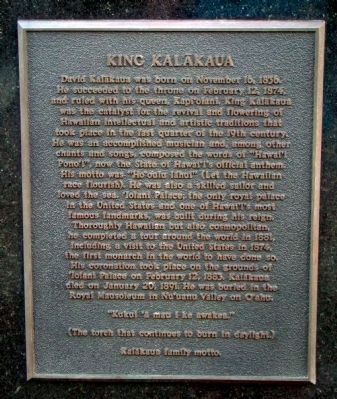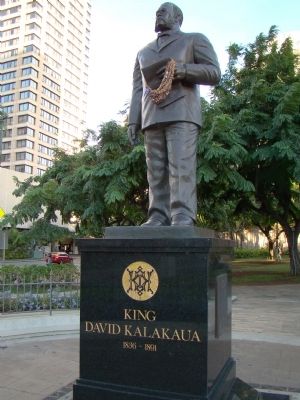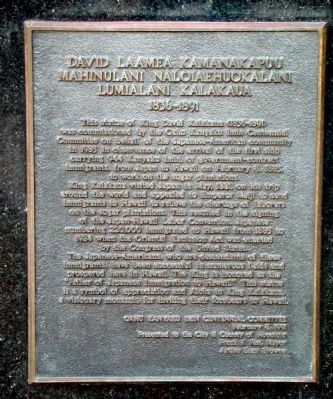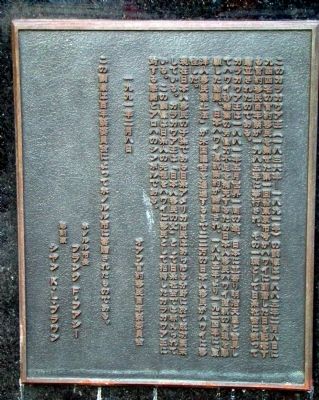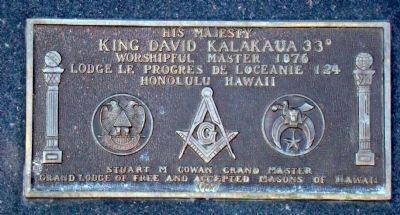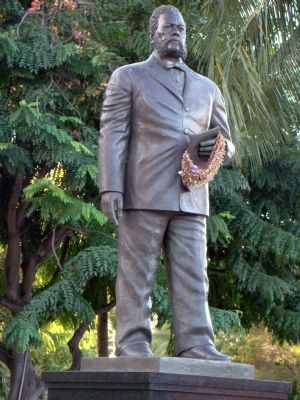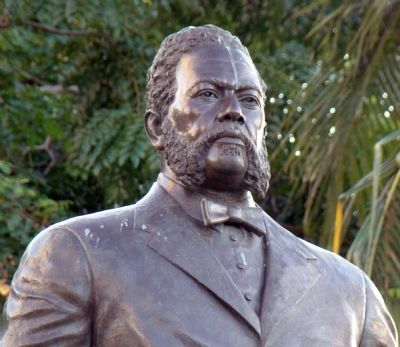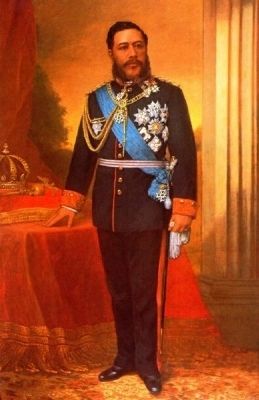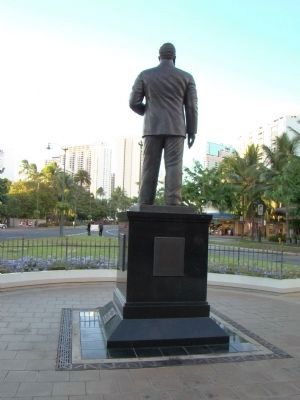Waikiki in Honolulu County, Hawaii — Hawaiian Island Archipelago (Pacific Ocean)
King David Kalākaua
1836–1891
(tablet on back of base)
David Kalākaua was born on November 16, 1836. He succeeded to the throne on February 12, 1874, and ruled with his queen, Kapi‘olani. King Kalākaua was the catalyst for the revival and flowering of Hawaiian intellectual and artistic traditions that took place in the last quarter of the 19th century.
He was an accomplished musician and, among other chants and songs, composed he words of “Hawai‘i Pono’i,” now the State of Hawaii’s official anthem. His motto was “Ho‘oulu lāhui” (Let the Hawaiian race flourish). He was also a skilled sailor and loved the sea. ‘Iolani Palace, the only royal palace in the United States and one of Hawai‘i’s most famous landmark, was built during his reign.
Thoroughly Hawaiian but also cosmopolitan, he completed a tour around the world in 1881, including a visit to the United States in 1874, the first monarch in the world to have done so. His coronation took place on the grounds of ‘Iolani Palace on February 12, 1883. Kalākaua died on January 20, 1891. He was buried in the Royal Mausoleum in Nu‘uanu Valley on O‘ahu.
“Kukui ‘ā mau i ke awakea.” (The torch that continues to burn in daylight.) —Kalākaua family motto.
(tablet on right side of base)
David Laamea Kamanakapuu Mahinulani Naloiaehuokalani Lumialani Kalakaua, 1836–1891. This statue of King David Kalakaua (1836–1891) was commissioned by the Oahu Kanyaku Imin Centennial Committee on behalf of the Japanese-American community in 1985 in observance of the arrival of the first ship carrying 944 Kanyaku Imin, or government-contract immigrants, from Japan to Hawaii on February 8, 1885, to work on the sugar plantations.
King Kalakaua visited Japan in May, 1881, on his trip around the world and appealed to Emperor Meiji to send immigrants to Hawaii to relieve the shortage of laborers on sugar plantations. This resulted in the signing of the Japan-Hawaii Labor Convention. Japanese numbering 220,000 immigrated to Hawaii from 1885 to 1924 when the Oriental Exclusion Act was enacted by the congress of the United States.
The Japanese-Americans, who are descendants of these immigrants, have been successful in numerous fields and prospered here in Hawaii. The King is honored as the “Father of Japanese Immigration to Hawaii.” This statue is a symbol of appreciation and Aloha to King Kalakaua, a visionary monarch, for inviting their forebears to Hawaii.
(tablet on left side of base)
このカラカウア王 (一八三大 年|一八九一年) の銅像は、一八八五二月八日に 九四四名の官約移民を乗せた最初の船が到着した日を記念す る官約移民百年祭が一九八五年に挙行され、その一環として日経会社によって 建立されたものである。
カラカウア王は、世界中一周の彼の旅行の際、一八八一年五月に日本を訪れ、砂糖業(プランテーション)で労働者の不足を緩 和するためにハワイに移民を送るように明治天皇に訴えた。これは、日本ハワイ渡航条約の締結をもたらした。「東 洋人移民禁止法」(オリエンタル除外法)が米国の議会によって制定されるまで、二二万の日本人がハワイに移 住した。
これらの移民の子孫である日系アメリカ人は、数多くの分野で成功して、繁栄 してきた。カラカウア王は、「ハワイへの日本人移民の父」として日系社会では称えられて いる(表彰されている)。この銅像(彫像)は、ハワイに彼らの祖先を招待した、カラカウア王 への感謝とアロハのシンボルである。
一九九一年二月八日
この銅像は百年祭委員会によりホノルル市に寄贈されたものである。
ホノルル市長 フランク F・フアシー
彫刻家 シヤン K・L・ブラウン
Erected 1991 by the Oahu Kanyaku Imin Centennial Committee. Presented to the City and County of Honolulu on February 8; Frank F. Fasi, Mayor. Artist: Sean Browne.
Topics. This historical marker is listed in these topic lists: Asian Americans • Government & Politics • Settlements & Settlers. A significant historical month for this entry is January 1740.
Location. 21° 17.035′ N, 157° 49.9′ W. Marker is in Waikiki, Hawaii, in Honolulu County. Marker is at the intersection of Kalakalua Avenue and Kukio Avenue and Kuamoo Street, on the left when traveling south on Kalakalua Avenue. It is in Waikiki Gateway Park. Touch for map. Marker is in this post office area: Honolulu HI 96815, United States of America. Touch for directions.
Other nearby markers.
At least 8 other markers are within walking distance of this marker. “Brothers in Valor” Memorial (about 500 feet away, measured in a direct line); Fort DeRussy (approx. 0.2 miles away); Kuroda Field (approx. 0.2 miles away); Kãlia Fishponds (approx. 0.2 miles away); Helumoa (approx. ¼ mile away); The Story of Kālia (approx. ¼ mile away); Kaha ha ʻlo me nā Makani (approx. ¼ mile away); U.S. Prefabricated Pill Box (approx. 0.4 miles away).
More about this marker. The sculpture was commissioned by the Oahu Kanyaku Imin Centennial Committee at a cost of $100,000 and commemorates the arrival of Japanese immigrants to Hawaii. The Committee had originally intended to have the sculpture placed on the grounds of Iolani Palace, but because it did not pre-date 1893, it could not be placed there. The sculpture was cast in Italy; the base designed by Leland Onekea & Partners. ... In 1993, the Centennial Committee also donated a plaque to be placed on the Diamond Head side of the base, which gives a brief narrative history of King Kalakaua written by Professor Nancy Morris, University of Hawaii. The approximate value of the plaque including installation: $2,000. —from the Smithsonia Institution’s SIRIS Art Inventories
Catalog.
Also see . . . Kalākaua I. Wikipedia entry. “In 1881, King Kalākaua left Hawaiʻi on a trip around the world to study the matter of immigration and to improve foreign relations. He also wanted to study how other rulers ruled. In his absence, his sister and heir, Princess Liliʻuokalani, ruled as regent. The King first traveled to San Francisco where he was given a royal welcome. Then he sailed to the Empire of Japan where he met with the Meiji Emperor. He continued through Qing Dynasty China, Siam, Burma, British Raj India, Egypt, Italy, Belgium, the German Empire, Austria-Hungary, the French Third Republic, Spain under the Restoration, Portugal, the United Kingdom of Great Britain and Ireland, and back through the United States before returning to Hawaiʻi. During this trip, he met with many other crowned heads of state, including Pope Leo XIII, Umberto I of Italy, Tewfik, Viceroy of Egypt, William II of Germany, Rama V of Siam, President Chester Arthur, and Victoria of the United Kingdom. In this, he became the first king to travel around the world.” (Submitted on November 15, 2008.)
Additional keywords. Pacific Islanders
Credits. This page was last revised on February 10, 2023. It was originally submitted on November 15, 2008, by J. J. Prats of Powell, Ohio. This page has been viewed 2,698 times since then and 114 times this year. Photos: 1, 2, 3, 4, 5, 6, 7, 8, 9. submitted on November 15, 2008, by J. J. Prats of Powell, Ohio.
